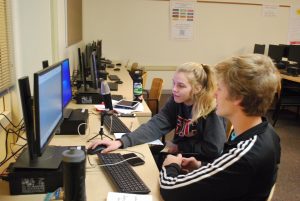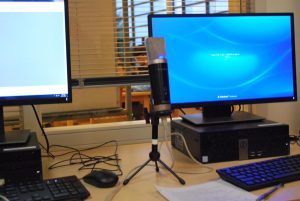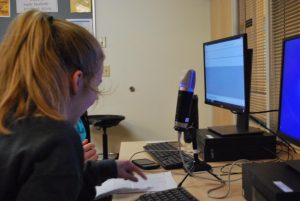“Story to Light”: Faith and Media Seniors Produce Podcast Series
December 12, 2018
High school students are well aware that learning a new unit in class or reading an assigned book will almost always be accompanied by an essay, project, or test. For La Salle students, this is the routine in many of their courses, so that teachers can see the knowledge and understanding their students have gained on the subject material.
However, this is not the case for every class.
Set apart from any other class offered at La Salle is Mr. Kendrick’s Faith and Media course, a new online class offered for seniors this year, in which students are faced with two unique challenges: to connect media such as movies, books, and music with Christian theology, and to reflect on these connections through the creation of their own podcasts.
The Faith and Media podcast series, which is called “Story to Light”, is centered around the core themes explored in the course, which include topics such as sin and redemption, violence, beauty, and vocation.
Mr. Kendrick said that because podcasting “tends to be best done as a conversation,” students are required to bring in at least one additional person to talk with in their podcast. Some students chose to make their podcasts with each other, while others chose to bring in teachers or family members.
Lenora Mathis, Ana Marie Martinez, and Samantha Kar worked together to put together their first podcast episode, in which they discussed the connections they made between the 2014 movie “A Most Violent Year” and the theme of violence.
“The introduction and road map for the podcast were planned out, but the rest of it was not,” Mathis said. “We ended up even straying away from our original plan and just talked about the movie candidly for about 40 minutes.”
The decision to use podcasts as the main form of reflection in the Faith and Media class was largely based on Mr. Kendrick’s desire for students to have real, quality conversations about the media they are looking at. Mr. Kendrick said that “because it is an online course, those conversations don’t generally happen, so I wanted the product to reflect the conversations.”
This was one of the reasons behind Mr. Kendrick’s desire to teach this course. “I love watching or reading a book and then discussing it with people,” he said. “I wanted to design something that would reflect the amount of work students put into it and also be worth doing.”
Mr. Kendrick put together a large selection of choices for each student to pick from throughout the course of their learning in Faith and Media. “One of the things with the online course is that students drive their curiosity,” Mr. Kendrick said, explaining that he tried to offer as much choice as possible with all aspects of the course.
For their first podcast episode in which they discussed the connections they found between movies and faith, students could choose from the following movies: “The Hunchback of Notre Dame”, “The Mission”, “Les Miserables” (1998), “Les Miserables” (2012), “Changing Lanes”, “Blood Diamond”, “In Bruges”, “Calvary”, “A Most Violent Year”, “Spotlight”, and “Hacksaw Ridge.”
Brigid Hanley and Ting-Chien Huang decided that they would focus their podcast on finding the beauty within the 1996 Disney movie “The Hunchback of Notre Dame,” which they chose because they wanted to discuss judgment in our society based on looks.
Huang described the podcast creation process as “hectic,” saying, “we were doing it practically last minute and had no real experience in making a podcast.”
However, after watching “The Hunchback of Notre Dame” with this theme of beauty in mind, the two of them found that “the movie was a great example of how society often doesn’t give people who don’t meet some superficial standard the benefit of the doubt, and judges them harshly until they are able to prove themselves,” Huang said. “Brigid and I knew that this wasn’t right and wanted to speak out against it.”
Mr. Kendrick said the goal of the class is for students to develop a “theological sense.” He said, “some of the movies students have watched they think this have nothing to do with religion, and then I’m like, if you actually start looking for some of these things you will start seeing Christian theology in a lot of different things.”
Isaac Calvert-Russell chose to watch the 2016 movie “Hacksaw Ridge” for his podcast, and to look for the connections to faith and integrity present in the film. “I chose this because I think it is a very powerful movie that said a lot about faith and integrity,” he said.
The name and logo for the podcast series “Story to Light” were both created by Faith and Media students themselves. “Everyone had to come up with a design and a title, and then we went through several rounds of honing what we wanted and people choosing what they want for the logo and their rationale for that,” Mr. Kendrick said. “We paired it down and ended up choosing Maggie Cavanaugh’s logo and Brigid Hanley’s title.”
“Story to Light” also features music produced by 2018 La Salle graduate Sam Jensen.
“I know for myself as soon as I learned to do this, I can’t turn it off, like I can watch pretty much any show or movie and [think about] how this relates to faith,” Mr. Kendrick said. “Regardless of whether these are coming from religious sources or not, a big pool of people are wrestling with faith or with forgiveness and we should see this as common ground as we try to understand ourselves.”











